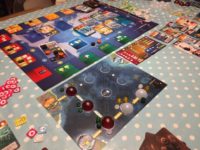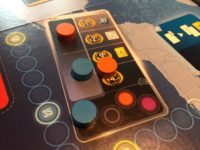- Learning time
- 60 minutes
- First play time
- 180 minutes
Underwater Cities
Designed by: Vladimír Suchý
Underwater Cities is set in the distant future, when – unable to successfully live on the surface of the planet – humans are retreating to beneath the water. Players represent the entrepreneurs of this brave, if somewhat nightmarish (for hydrophobes) world, building the cities and tunnels at the bottom of the oceans…
Each player gets a playmat with their starting city on the bottom-right, represented by a plastic dome. Players also start the game with three cards and three action markers. The board itself shows what actions are available to each player, with the not-inconsiderable caveat that actions are only available if no-one has yet claimed them on any given round. The actions are all geared towards realising your mammoth building projects: cities, along with adjacent bases: farms, labs, and desalination plants. You’ll notice too that each action has a colour: orange, red or green. To take an action, you place your action marker on it and play a card: if you play a card of the matching colour, you get to do the action on the card as well!
Most actions are reasonably straight-forward: build a city, build tunnels, build a base, and so on. But to do these things you’ll need resources – available from other action spots – and Underwater Cities has plenty of them: money (or credits, to use the game’s parlance) steelplast, kelp, science, biomatter. Other actions allow you to take more cards into your hand – crucial in a game where synergising actions and cards can prove to be the difference between winning and losing – or upgrade your farms, labs, plants or tunnels. Why upgrade? Because three times in the course of the games’ ten rounds there is a production phase where all of your bases produce for you: all of your much-needed resources are suddenly – one hopes – being churned into your lap. Upgraded bases do more churning, and two upgraded bases in the same city provide a jackpot-esque income of stuff to help further your progress… Also in the production phase: feed your cities. This is important, as not being able to costs you precious victory points!
But we mentioned the cards too: having a card that matches the colour action you’re taking means you can action the card as well, and some of these are extremely juicy. There are several types: one-off cards that give a single reward, improvement cards for ongoing benefits, production cards that give more boosts in the aforementioned production phase, and action cards that can only be actioned via certain action spots on the board. After each of the first two production phases, new more powerful cards appear, and the heart of the game is really about trying to maximise the opportunities for the rewards on them, and minimise the times you take an action with no card reward at all. Also available are special cards (free to collect, but cost you money to play) and Government contracts, that trigger an instant reward to the first player to complete them: this might be build six tunnels, say, or another construction-based goal.
After the tenth round and a final production phase, players will score points based on the extent and diversity of their city network, the combined worth of their left-over resources, and any cards that score end-game points. Most points is king of the sea!
The guru's verdict
-
Take That!
Take That!
No direct interaction at all, but someone is just destined to take the action spot, or a card, or a contract you desperately hoped for. While it might be inadvertent, it can be crushing as well!
-
Fidget Factor!
Fidget Factor!
Very high on that first play, dropping and dropping with subsequent plays. Frequent play will get the playtime down to the box's alleged, but seemingly optimistic, 30-45 mins per player.
-
Brain Burn!
Brain Burn!
As is often the case with these apparently 'heavy' games, the heart of it is reasonably simple and intuitive - in this case, Choose an Action. And hope to match the colour with a card of the same colour. But despite the 16 actions - or less - to choose from, there are weighty decisions to be mulled around it. Cities are good but need feeding. Bases are good but need resources to build them. You may find that your Plan A and Plan B are both stymied by desirable action spots being taken.
-
Again Again!
Again Again!
Huge variety here: Action cards, special cards, government contracts can all vary from game to game. And so can your approach: a grand strategy is helpful, but it's possible to play a kind of passive-aggressive guerrilla fighter: spoiling others' plans and harvesting points as you do so.












Sam says
Like a number of games, there's a fair bit of iconography to get your head around owing to the industry's love of (or reliance on) language-independent components. And there are one or two wrinkles we've not covered here, such as symbiotic cities (which score points!) and how turn order (vital in this game) is decided. But unlike many games of this weight, the story doesn't disappear into abstraction when you start playing, and although it's not lavishly produced everything you construct has a pleasing tactile aspect to it: you are literally building the cities, tunnels and bases by adding them to your board. That really helps with both comprehension and the experience. It is long though: with four players especially you may need a pot of coffee/several brews to see you through the whole ten rounds - in fact it's probably best experienced with two or three. But for those gamers who like the non-combative nature of the play, the theme of it and the canny strategizing opportunities, this is worth persisting with. The action/card matches throw up both moments of agonised frustration and delight when it all comes together and you pull off a move that catapults you into the lead...